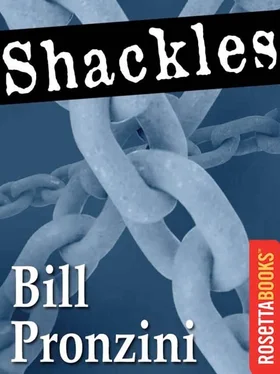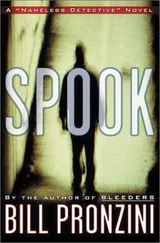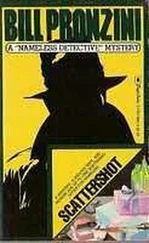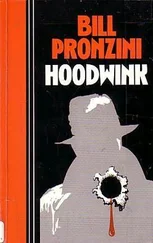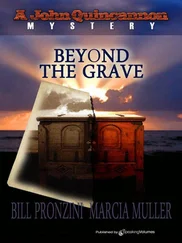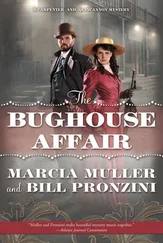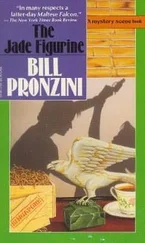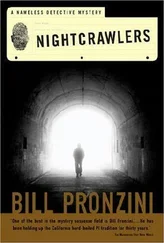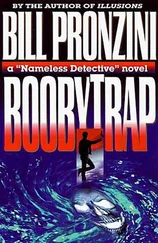That was the last thing; now I was ready. I caught up the snowshoes, went to the door, and walked out into the chill morning.
Whiteness carpeted everything within range of my vision. Downhill to my left, an avenuelike break in the spruce forest marked the probable course of the access road. After I had gone forty yards or so I stopped and turned to look back at the cabin, to fix in my memory its exterior design and its exact location. I hoped to Christ I would never have to come back here; but if I did I wanted to be able to recognize it easily from a distance.
The snowpack was slippery but the drifts didn’t become a problem until I was in among the trees, where there was a series of little ridges and hollows. In the low places the drifts were calf-high and it was like trying to wade through a dense mixture of water and sand. When I came onto a section of higher ground where the snow was only a couple of inches deep I strapped on the showshoes and tied the thongs around my ankles. It took me a couple of minutes, and a near fall, to get the hang of walking on them. You had to keep your legs wide apart to prevent stepping on one showshoe with the other, and you had to swing your legs in a kind of waddling gait to maintain balance. Otherwise, snowshoeing wasn’t much different from normal walking.
Once I got used to them I made good time, following the winding break through the spruce forest. The wind had picked up and I was conscious of its steady whine and rattle in the stiff tree branches; but it was behind me and it didn’t penetrate the warm layers of fabric around my body. Because I had no gloves, I kept my hands bunched down deep in the overcoat pockets. The cold got to them anyway, and seeped under and through the tied towel to numb my ears, but there was no pain or discomfort yet. On the contrary the cold gave me a muted sense of exhilaration. It was different from the cold I had felt inside the cabin all those weeks, refreshing, invigorating-a reaffirmation of the freedom that was mine again.
The long downslope ended in another hollow, this one much wider and flat-bottomed and deep-drifted. The second hillock, steeper than the one I’d just descended, rose on the far side. The trees thinned out ahead and most of the upslope was bare, so that I couldn’t be sure of where the road continued up and over. I made a guess and started up.
Snowshoeing was more difficult on an incline; I began to get tired before I had reached the halfway point. I tried moving in a zigzag pattern and that made the going a little easier. Near the top and directly ahead of the course I had set, dwarf fir and the tips of jagged ice-rimmed rocks poked up out of the snowpack. This couldn’t be where the road was, then. I veered away from the rocks, diagonally to my right.
I was forty or fifty yards from the top when a hidden outcrop snagged my right snowshoe and pitched me off balance. Reflexively I thrust the other shoe forward to catch my weight but it slipped on the icy surface of another rock, angled down through the drift and into what must have been a cavity between the rocks. There was a sharp snapping sound and I went down sideways into deep snow that billowed up and half buried me.
In frantic movements I jerked my right leg free and struggled around onto my buttocks, spitting snow and wiping it out of my eyes. When I tried to get up there seemed to be nothing beneath me to put my weight on. I rolled over, shivering; particles of snow had gotten under the collar of my coat, gone slithering down my back and chest. I still couldn’t get up and I had to fight off a thrust of panic as I floundered around again until I was facing downhill, my legs spraddled out below me. I could feel the ground, then, with my hands and hips. I managed to get both palms down flat, then pushed and twisted upward. It took two tries before I was able to heave myself erect.
But the frame on my right showshoe had snapped in two places; when I tried to put my weight on it it folded up around my ankle and threw me back down into the drift. The panic jabbed at me again, the same kind of panic a poor swimmer must feel in deep water. I rolled again, coughing snow out of my mouth and throat, blowing it out of my nose. I couldn’t see; everything had become a misty white blur. Once more I flailed over onto my buttocks, twisted upward. Finally managed to stand her-onlike on one leg, sawing the air with both arms until I had my balance.
I stood there wobbling, feeling crippled and anxious because I was out of my element, in a survival situation that I didn’t understand or quite know how to cope with. Maybe the right shoe would take a little weight, if I was careful… but when I tested it my right foot sank and I couldn’t free the left shoe to slide it forward, and I almost fell again.
Calm, stay calm. Think it through. Don’t do anything else without thinking it through.
I cleared my eyes, took deep breaths until the apprehensive feeling eased and some of the tenseness went out of me. All right. The first thing I had better do was to get rid of the snowshoes; the right one was too badly damaged and that made the other one just as useless. I untied the thongs, pulled off the right shoe and let that leg down as far into the churned up snow as it would go-thigh-deep. Then I took the other shoe off and got that leg down so that I was standing on both feet.
Walking was something else again. The first step I took, with my right foot, I sank to my hip on the left side. I tried it again and again, slowly and deliberately, and found a way to move forward and upward without losing my equilibrium, but each step netted me no more than eighteen inches of progress. The effort of moving, burrowing forward at this snail’s pace, was so great that I had to stop before I had gone more than ten yards.
I rested for a time, looking up at the crest of the hill. Maybe the drifts weren’t as deep along its flattish top, over on the other side; at least the going would be easier downhill. And if there was another steep hillock on the far side? One obstacle at a time. Get up to the top of this one first.
I struggled upward again, one short slogging step after another. It was slow, exhausting work and I had to stop twice more to rest my aching legs before I was able to cover the last few yards to the crown.
The snowpack was shallower up there. There were only a few spruce trees, nothing much else, and the wind had thinned the drifts down to a depth of less than a foot, exposed patches of bare ground along the far lip. Ahead and below, where the downslope flattened out into a long, wide, treeless snowfield, the drifts were unbroken and looked deep. But it wasn’t the drifts that caught and held my attention.
There was a road down there.
It ran along the far edge of the snowfield, where the terrain rose sharply into steep red-earth cutbanks and tree-clad hillsides. Its surface was mostly covered with a thin crust of snow, except for streaky areas where the wind had scoured it away and the asphalt showed through. But it was the high windrows flanking it on both sides that clearly identified it as a road, and gave me a small measure of relief. A snowplow had made those windrows; and no county sends out snowplow crews to clear mountain roads unless there is enough traffic to warrant it.
The road was maybe 300 yards from where I stood atop the hill-300 yards of wind-smoothed virgin snow. No telling from here just how deep the drifts were; I would find that out when I started wading through them. If I’d still had the use of the snowshoes, I could cover the distance in a few minutes. As it was…
I started downslope, keeping to the cleared patches wherever I could, and the first seventy-five yards or so weren’t bad. Then the drifts began to deepen, and before I was three-quarters of the way downhill the snow was hip-high and getting deeper. Flakes of frozen powder got into my clothing, burned where they touched bare flesh. My hands were stiff and numb inside the coat pockets. The wind was still up and it hammered at me, chilled my neck, sent tremors through my body.
Читать дальше
